Trip report from visit to NS Savannah
About three weeks ago, I wrote an article about commercial nuclear ship propulsion. That post introduced Benjamin Haas, a student at SUNY Maritime, who has been leading a design team that is developing the conceptual design for a nuclear powered shipping system.
Ben’s team is not just focused on the ship itself, but on all of the supporting infrastructure that will be required to operate a fleet of commercial ships taking full advantage of the technical capabilities offered by atomic fission in comparison to the current alternatives of diesel engines or combustion gas turbines.
Recently, I received an email from Benjamin that he agreed to let me share with you. He will participate in the comment thread, so if you have any questions about his recent trip or about the progress that he and his team are making with their nuclear ship designs, this would be a good chance to ask.
From: Benjamin Haas
To: Rod Adams
Subject: NS Savannah Visit with Photos
On Thursday April 3, the senior Naval Architecture class from SUNY Maritime toured the NS Savannah’s Containment Vessel and Engine Room. We donned dosimeters, signed the paper work, saw the steam generators, control drive mechanism, the piping, all the while being lectured on nuclear power and PWR’s by a former senior reactor operator for Calvert Cliffs (a graduate of SUNY Maritime): Clifford Marks.
He showed us the Savannah’s emergency diesel generator and talked to us about decay heat and melt downs. He taught us basic reactor physics and PWR operation. When in the control room, he physically showed us how the controls would have been operated to run the Savannah and how the NRC trained him. It was quite a feeling following the flow of a nuclear reactor with my eyes. My goodness, those PWR operators are SHARP!!
We were lectured on the history of the Savannah, Atoms for Peace, the NRC, and decommissioning by Erhard Koehler, the Savannah’s NRC licensee and MARAD program coordinator, also a graduate of our college. He covered “myths and legends” of the design, such as passenger-cargo ships not necessarily being a design disadvantage at the time (although certainly contributing after the airliners came about), and how MARAD actually wanted a bigger, faster vessel, but only got a limited amount of funds appropriated.
Giving a presentation on the Savannah about a nuclear shipping startup and national policy is very tantalizing… Probably in a few years when I have a white paper like Leslie Dewan’s group at Trans Atomic Power.
We had lunch on the vessel, pizza, in the salon. A large container ship passed by. The Alumni (two of our professors and the two Savannah workers) sat together talking while the cadets were in their own groups.
We saw demonstrations of Geiger counters using fiesta ware, uranium glass, and an old radium dial clock. It was just like all the videos I have watched. The Radiation Safety Officer was happy I knew it was a “pancake probe”. During the briefing, he used the term “pain” to describe paper work. People did not know what that meant and the thought entered my mind of radiation workers having blood drawn to measure internal exposure, although I think they take fecal samples? It was a funny moment nevertheless.
I am planning to write an article about the visit. We did not have the chance to debrief on our impressions since we drove straight back to NY. Some of the students I talked to were so very impressed and grateful for the visit. My design team had been looking forward to this trip since I told them I would get us a visit last year. My impressions is that most everybody was tired from a full day of learning.
We literally experienced up close a nuclear reactor and nuclear-powered ship, whose license and upkeep are still relevant.
I have attached some pictures from the trip. You finally get to see a picture of me and my design team.
Sincerely,
Benjamin Haas

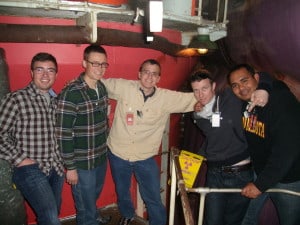
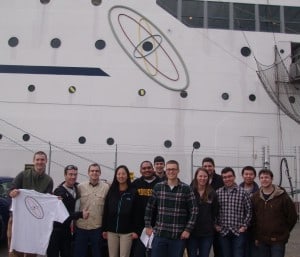
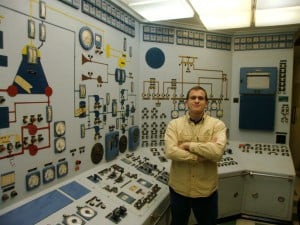
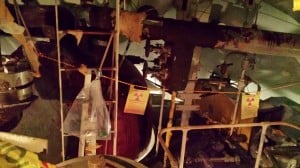
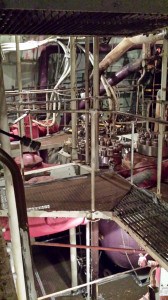
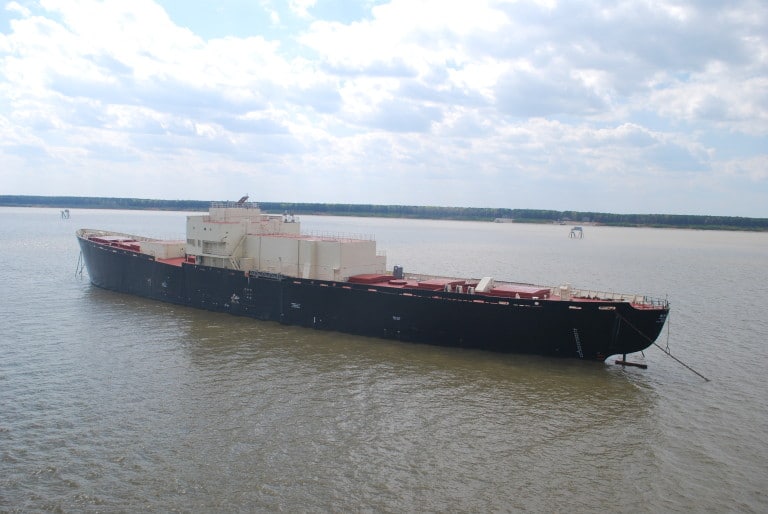
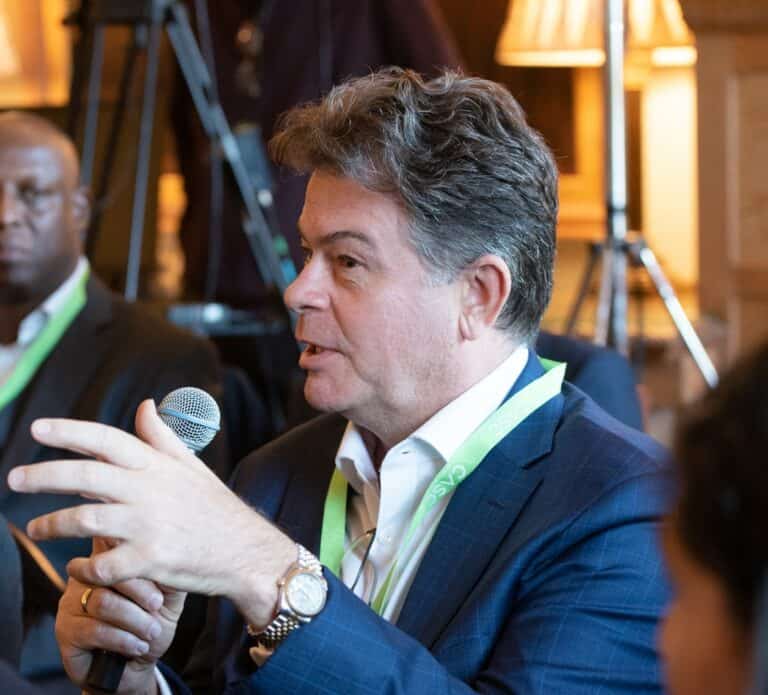
Rod, is all our experience with nuclear powered naval propulsion based on HEU reactors? Is there a significant difference in the size or cost of a naval reactor running on LEU?
@Robert Hargraves
The Navy uses HEU, but the NS Savannah used LEU enriched to less than 5%.
The Navy’s original choice was driven by the need to build a reactor that would fit into a 2,500 ton submarine – the USS Nautilus. As subs got bigger, and for surface ship reactors, there was no longer a technical requirement to use HEU in order to achieve critical mass. However, it is very good for enabling reactor cores that last a long time. USS Virginia class submarines have nuclear cores that last as long as the ship – 33 years.
That is not a particularly “commercial” decision since it requires buying (and paying for) all of the fuel the reactor will ever use several years before the reactor is even operating. The time value of money would tell a commercial customer that it is better to pay as you go instead of buying everything way before you need it.
Commercial ships would probably choose a design concept that makes it as easy as possible to refuel instead of one that makes refueling unnecessary.
Who would license a commercial ship with a reaktor? would there be problems with entering foreign waters?
Benjamin and Associates,Well written and researched presentation.
Comments on “Strategies for the Success of Nuclear Powered Shipping” by Benjamin Haas.
PDF page 13
“• Current pressurized water technology, as the world’s nuclear navies uses on their submarines and as used in current electricity generating plants, does not allow passive safety in the case of meltdowns.”
This is contrary to my understanding based on ‘60s vintage navy sub technology. Someone with more current navy knowledge correct me if I’m wrong, but the two designs I learned (W and CE) both had long term passive cooling. The plants were “walk away” safe, requiring no external electric power for long term core decay heat removal via natural circulation (gravity). The only thing required was keep the ocean fed heat sink full of water. If cooling down the coolant water system and its contraction is a concern it can be overcome with a passive pressurized accumulator tank. If the design requirement requires permanent loss of all electric power combined with a LOCA, even that is not inherently difficult inside a sturdy container. The USN currently has two of these on the bottom of the ocean. Even if the cores are melted inside the pressure vessel the total radiation source term does not change (other than decrease with time). If it was leaking out of the coolant system it is contained within that portion of the hull pressure boundary. If it was leaking to the ocean it would be detected by now (both have been located). By my understanding these designs were totally passively safe. The quickest route to success is “Dance with the girl what brung ya”
PDF page 28 and following
• “In the case of the construction of nuclear reactors, the greatest influence is from nuclear specific quality controls.”
• “There should be a significant area of research devoted to what is making nuclear construction/capital costs so high and what can be done to reduce them. This, after all, is the biggest issue the industry faces.”
• “An example of this in the modern era are the delays faced by the current construction of two nuclear reactors in South Carolina caused by missing documentation for the manufacturing of certain components.”
You can’t emphasize this too much and your discussion needs to be beefed up with suggestions. Currently you are addressing symptoms not root causes. Some history; the explosion of nuclear construction in the ‘70s and ‘80s diluted both the construction management and the labor pool expertise. The appreciation for the “nuisance of paperwork” got lost by that dilution. We face the same problem today, because the lack of 30 or 40 years of experience in labor, manufacturing, and documenting for these standards.
Cases in point; the Zimmer Plant was 100% done but had no weld QA program documentation. The welds may have been 100% satisfactory, but the regulator’s rightful position is you can’t prove it, so they are all junk. Do them all over, result… abandoned. Marble Hill, 2 units, 50% and 30% done, same issue but it’s the concrete QA documentation. Do it over because it’s junk; result… abandoned. Same problem as you discuss with the S.C. reactor construction, a QA problem in the sub-base rebar supplied by a sub contractor. Much of the US is currently not prepared to work to these standards on mass production scales, yet mass construction as you point out is required for the cost feasibility to be attainable.
This is a real problem, and it can undo the SMRs if they ever move to manufacturing and construction. All problems cost money to solve, so factor in a solution suggestion and its cost. It is not simply training, you must believe in the process and that is more about attitude.
The Regulatory Issue
First, I am in favor of your proposal. But i fear this is your largest hurdle. When it comes to the regulatory issue, the USNRC cannot deal with this problem. They are responsible (among other contributors) for the current high cost of commercial nuclear generating facilities. So I think you will need a totally new, separate regulatory structure. The cost of that is the responsibility of the ship owners. When you factor that in including all the special interests involved, you will have a really tough battle. It is not just the fuel cost; it is the total infrastructure required to make it happen.
When fossil fuel companies (who about run our government), and special interests, can successfully shut down operating nuke plants, how will you get them to agree with this plan? It uses substantially less oil; they don’t want it to happen. Unfortunately it is the reality we face.
You don’t have to specifically respond, unless you feel the need. Overall, a very good job.
We need a grass roots education effort, similar to what NORML has accomplished in the decriminalization of Marijuana. I know it can work because I am a result of this effort!
About a decade ago I was vehemently anti-nuclear and a paying supporter of Greenpeace, I even tabled and protested with them a few times. it was only reading comments by pro-nukes and finally a conversation with DrBuzz0 that changed my mind (I won’t state his real name as I’m not sure if he wants it public). Over the last few years I have been working to change the opinions of those around me as well.
The recent plant closing in California makes me realize even more must be done. I might not have a plant that is under threat near me, but at this point I don’t care anymore, the problem environmental protection is global. After a little research, just in my local area the people who write letters to the editor and comments against nuclear power number less than a dozen. They have been at this for years and the “silent majority” (to use a phrase from Nixon) need to stand up and be heard. I finally got around to joining CASEnergy coalition and writing my representatives when anything germane to nuclear power comes up.
I have other ideas as well, if I find like minded people in my area (St.Louis MO) I would be interested in tabling and seeing how many people are willing to engage us in a discussion. Getting tritium keychains so people can see what it is Greenpeace rails against would be another solid idea (however most places which allow tabling, i.e. Universities do not allow selling items, but the sale of Tritium keychains could be a source of funding for local pro-nuke groups).
Finally, every single game which simulates an electric grid is either very limited or gives far too much credit to renewable power. A game given out free for iPhone and iPad where the player gets to design and operate a grid would be a great way of providing some fun while entertaining people. It could also be shown off when tabling.
BACK TO THE TOPIC AT HAND, very cool. I am jealous! US ship builders need to realize that China and Russia will develop technology with or without us, the US is not in a position to stifle the development of nuclear power any longer.
Actually to be more specific, it was heated debates with pro-nukes that changed my mind. I know, I know… we environmentalists might seem like hopeless deluded souls. I don’t think any of the people I debated honestly felt they had gotten anywhere with me. I’m sure they felt they were arguing with a brick wall. It was only after the arguments had sunk in and the pain of admitting I was so wrong wore off that I could admit to myself my opinion had changed, let alone anyone else.
“I might not have a plant that is under threat near me, but at this point I don’t care anymore, the problem environmental protection is global.”
Aye! Here in Australia we’re thousands of kilometres from the nearest NPP, but if it closes the CO2 from the fossil fuel plant operated in its place still affects us equally!
Did Australia ever seriously look at building nuclear power plants?
On a national level it seems an obvious choice, free up more coal for export to China where demand is only going to increase in the future. Once Australia got more domestic expertise, they could build them in series and using use the thermal energy to run coal gasification. When China begins switching off of coal a few decades from now Australia would be ready to step in with gas exports about the time Russia’s production begins dropping. It would a license to print money.
Next to a coastal picnic spot we still have parts of the base pad concrete for a reactor planned in the 60s, south of Sydney. It would have been a seawater-cooled heavy water reactor, probably designed around weapons plutonium production but possibly to be connected for electricity.
We have a definite push here in South Australia (with 3 uranium mines) to establish nuclear. For all the technological reasons you mention, and more. I see it as likely the difference between socioeconomic triumph and permanent obscure irrelevance.
Wikipedia has an informative article on Nuclear Power in Australia, and a brief description of the Jervis Bay Nuclear Power Plant proposal. Heavy-water reactors are not without commercial utility: they are popular in Canada and do not require uranium enrichment although modest enrichment is sometimes used.
I think DrBuzz0 is fine with sharing his name, based on his about page on Depleted Cranium.
http://depletedcranium.com/about-dr-buzz0/
The regulatory hurdles involved with entering foreign waters would be daunting.
What I am wondering if there is a (possibly niche) market for a transoceanic towing service (push or pull).
I am imagining a nuclear powered “tugboat” that would never need to enter foreign waters, it would just get the container ship close..
Is there a particular class of cargo vessel that would be well suited?
Chris,
Not so difficult from a regulatory standpoint. Political barriers is another matter.
Commercial vessels already must meet the requirements of their flag state and the ports with which they trade; for example, if a vessel is found to not meet the minimum requirements for communications equipment, it will be prevented from sailing (or given a temporary exemption). Petroleum tankers and chemical tankers are subject to very strict regulations while in port; in the United States at least, Coast Guard officials will board chemical tankers to observe certain cargo operations. For modern nuclear ships, it is simply determining what those regulations will be.
Lloyd’s Register took a look at modern nuclear ship rules a few years ago. It was not comprehensive in the slightest, but it does make some useful recommendations and it questions current radiation regulations. Lloyd’s interest in the topic shows that at least one of the marine class societies is volunteering its time to look at nuclear power.
Liquefied Natural Gas carriers and LNG-fueled ships actually face similar design concerns as nuclear ships: collision protection of the cargo/fuel tanks, grounding protection, and security zones for LNG tankers when in port. The NS Savannah followed a similar protocol. The Savannah had Port Operating Plans developed for each port that outlined emergency procedures for its design-basis accident. One such procedure was limiting the amount of people that could be within certain distances of the ship at any time. This was because the Port Operating Plans used collective dose.
The challenge for many countries accepting the Savannah was not so much its safety than it was insurance coverage for an accident. If my history is right, the Netherlands would not accept the Savannah until the U.S. government guarantee the insurance coverage would exist for an accident. This is what got the Savannah included in the Price-Anderson Act and Rotterdam was one of the ports-of-call. With passively safe reactors, I believe protection and indemnity can be acceptable.
Does anyone know where to purchase BULK Tritium keychains?
Or what the procedure would be getting tritium and assembling them? I purchased five a few years ago, but have since given them all away. Through a professional contact I have weekend access to a 5 axis CNC machine and a fume hood (so I can safely work with the needed resins or acrylic). The only problem is the tritium, purchasing individual vials is too expensive.
It would be helpful if the USN would convert its surface fleet to be powered by reactors; this would build the industrial base and a similar design could possibly be used by commercial shippers. This would also help with the licensing and regulatory issues, after all our LWR reactors for the grid are descended from the Navy’s reactors. Deja vu all over again 🙂
I saw a news article recently about the navy testing rail guns for fairly soon (5 years?) deployment on surface vessels. If rail guns become common, it seems like they’d almost have to go nuclear. You wouldn’t want your armament and defenses silenced because you don’t have enough fuel to both maintain way and generate electricity.
There are two reasons why the US doesn’t use reactors in surface ships other than carriers any more that come to mind immediately.
First is that some foreign countries don’t allow nuclear vessels into their ports. This would cause operational problems if cruisers, frigates and amphibious assualt ships couldn’t access these ports.
Second is the cost of a reactor plant compared to a more convential power plant as a percentage of the total ship cost.
The first problem is a political issue that has no easy solution. But the second problem is easier to tackle. A big bonus to going nuclear is the savings in fuel costs and reduction in CO2 emissions. Also not having to periodically refuel would add to operational flexibility. And for anyone that has ever been involved in an underway refueling, just imagine having to do that under possible battle conditions and how vulnerable both vessels are.
@ddpalmer
First is that some foreign countries don’t allow nuclear vessels into their ports. This would cause operational problems if cruisers, frigates and amphibious assualt ships couldn’t access these ports.
That is simply not true. Not only do dozens to hundreds of ports welcome US nuclear submarines, but the US did build and operate 9 nuclear powered surface ships that were not aircraft carriers. The decision to stop building nuclear powered surface ships and to retire the ones that already existed had NOTHING to do with port access. The history is way too complicated to cover in a comment to a blog post, but the myth of lack of port access is simply that – a myth with little basis in reality.
Then I guess I will have to go back and rewrite the actual exeprience of myself and my shipmates of not being allowed to pull into some ports. I also know that the US Navy DID build 9 surface ships that weren’t carriers, hence my being sure to say “surface ships other than carriers any more”.
I’m not denying that “some” ports, notably New Zealand, did not allow nuclear ships. I am denying that relatively minor inconvenience had anything to do with the US decision to stop building nuclear powered surface ships. You served on nuclear powered ships, but were you in a decision or policy making role?
By the way – most ports would not allow my “ustafishes” to enter, but that was because of our armament, not our power plant. That lack of port access did not stop the US from building and continuing to operate SSBNs.
Rod,
Would you write a post (or post a pointer) explaining the USN’s move away from having nuclear-powered cruisers, destroyers, et cetera? I’d search for it on the web but I’m not sure that I’d trust much of what I would find.
@ddpalmer;
“Second is the cost of a reactor plant compared to a more convential power plant as a percentage of the total ship cost. The first problem is a political issue that has no easy solution. But the second problem is easier to tackle.”
You are correct if you want to focus on symptoms rather than root cause. I prefer root cause fixes. The cost issue is actually based on “political” problems also; if one is paying attention and knows the history. So your “no easy solution” is correct…. sort of.
In theory the political problems can be solved by “we the people”; in practice, not so much.
As Rod says, discussion is beyond the scope of a comment process. And even if this subject was discussed in a separate blog post, those comments will show why “we the people” don’t have the will to solve the problem.
@mjd
In theory the political problems can be solved by “we the people”; in practice, not so much.
If “we the people” can attract the full support of enough of “they, the powerful,” perhaps we have a better chance than you think. As I like to remind myself, there are a lot more energy consumers in the world than energy producers. Some of those consumers have even more clout than the producers, but they have not quite gotten to the point of understanding just how much capability they have been ignoring for the last 40 years.
I’m in the fortunate position of having been privileged to attend a pretty good school with some pretty well connected people, yet I have also worked closely with a large number of “we the people” for most of my career. It’s an interesting position to be in, and I continue to seek ways to bring the “the rest of us” together with the powerful who can make serious changes in out current business-as-usual approach to energy.
Many of us interests in reliable, clean, abundant, cheap energy that are not shared by much of the Establishment in our Hydrocarbon Economy.
Rod, You and I probably totally agree on a lot of levels. I’ve read your posts for a few years, and I agree the “Establishment in our Hydrocarbon Economy” is basically driven by business decisions. I get it, big oil, NG, and coal see no reason to support nuke power in the short term. Even to the point of taking “hidden” action to make it go away. If my value system was totally driven by the love of money I’d be right there with them. So to me it’s basically moral values issues, not really political or tech that currently drives our process. I can’t fix that problem, not qualified. I can fix a defective flat tire but I can’t fix the guy who knowingly sold it to me (well I could, but my moral values system won’t allow it).
There appears to be an interesting exception.
http://nextbigfuture.com/2014/03/terrestrial-energy-integral-molten-salt.html
is one of several posts on Next Big Future about one kind of nuclear reactor being funded partly by oil sands interests because they want cheap steam for extracting bitumen without strip mining.
@Jim Baerg
Most people who like to sell fossil fuels don’t actually dislike nuclear energy. They dislike THEIR customers switching to nuclear energy.
Russia and the UAE are building nuclear plants for their domestic electricity production because it is a logical way to stop burning their own resources when they make a lot more money selling those same resources in the export market. Most extractors can only extract a finite quantity from their reservoirs each year. The more they sell to people willing to pay the highest possible prices, the better — for them.
Russia, on the other hand, has often supported antinuclear activities in their customer nations. Again, they don’t like it when their customers replace fossil fuel consumption with nuclear fission.
It’s all about the money. There is no ideology or fear factor here.
What would be cool tourist bait is building a exact replica of the orginal reactor where it was and also souping up that reactor control room into a “real” working simulator for people to see how it all worked under various conditions!
An interesting article, Benjamin – and thanks to Rod for sharing it.
Benjamin, I am the Communications Director for the N.S. Savannah Association, and am also its Historian. I might be able to provide you with some further information on this and other nuclear ship projects, and in addition I’d be interested to open up a discussion with you about some future opportunities with our organization. If you get a chance, contact me directly at atomicpower at willdavis dot org.
@ Jim Baerg April 17, 2014 at 2:49 PM. Yes sounds interesting, especially the time frame and reasons it is not currently possible in the US. Even with a change in our US regulatory structure there are still potential lessons to be learned in the US from the late ’80s relative to new large projects and QA issues. There is no substitute for experience and it has been lost in the US due to lack of new nuke projects. Here’s another history lesson example:
http://en.wikipedia.org/wiki/Midland_Cogeneration_Venture
That plant was a geographic neighbor to the one I worked at. It was 85% done and abandoned (but they did save the steam lines). I blame it on a lack of QA attitudes.
Rod,
As an aside,
You’ve commented on fusion negatively before, and I think you’d find this interesting:
http://www.askmar.com/Robert%20Bussard/The%20Trouble%20With%20Fusion.pdf
The author of “The Trouble with Fusion” a 1983 article in MIT’s Technology Review, written by a hot fusion plasma researcher may be interesting to you. He advocates for small, modular, inherently safe fission reactors at the end.